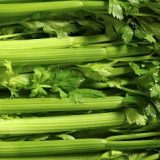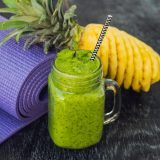Top 6 Reasons You Need to Use Honey

Geri Wohl, CNC www.bettereatingcoach.com
Do you get overwhelmed like me when you go down the supermarket aisle searching for a container of honey? Should you get the clover, wildflower or buckwheat? The regular honey bear or raw honey? So many choices of honey without knowing how to evaluate which one might be best for you.
Honey is a product made by honeybees for their nourishment. To make one pound of honey, the honeybees will need to feed on over 2 million flowers—that’s a lot of buzzing around! Honey making begins with honeybees traveling several miles to collect nectar from flowers through their mouths. Enzymes in the bees’ saliva create a chemical reaction turning the nectar into honey. Upon returning to the hive, the bees deposit the honey into the walls where the worker bees continue the process of honey formation. The bee wings’ rapid fluttering aerates the honey, decreasing the water content of the honey resulting in the oozing consistency with which we are all familiar. Both the texture and the flavor of honey are dependent on the type of flowers that the honeybees choose to pick. With over 300 varieties of honey in the US alone, we can sample many different flavors. Common flowers used in honey are clover, alfalfa, heather and acacia. Less common types are thyme and lavender.
Honey has been used for nutrition, healing and religious ceremonies dating back to ancient times. The collection of honey probably began around 6000-7000 BCE. Prehistoric records indicate that honey has had many uses but given our body’s need for sugar, which was then in short supply, honey was a relatively easy source to fuel our bodies and brains with a simple carbohydrate. In addition, honey is easy to digest and doesn’t need fancy storage. Thus it was perfect for our ancient ancestors. Honey, the end result of apiculture (the keeping of honeybees to make honey) was important in religious ceremonies where the people paid tribute to the gods and used honey to embalm the deceased. Moving forward in time, our early ancestors found the value of honey both medicinally and cosmetically.
 Honey is primarily comprised of carbohydrates in the form of fructose (38.5%) and glucose (31%). It’s also about 17.2% water. The rest are other forms of sugar, a small amount of protein (0.1 grams) and trace minerals and vitamins. Keep in mind that 1 tablespoon of honey is 64 calories with 17.3 grams of sugar. A little honey goes a long way! Riboflavin (B2), vitamin B6, iron and manganese are some of the vitamins and minerals found in honey. Some of the beneficial effects of honey are due to its flavonoids and plant hormones. So besides being a sweetener and substitute for white sugar, why should we use honey?
Honey is primarily comprised of carbohydrates in the form of fructose (38.5%) and glucose (31%). It’s also about 17.2% water. The rest are other forms of sugar, a small amount of protein (0.1 grams) and trace minerals and vitamins. Keep in mind that 1 tablespoon of honey is 64 calories with 17.3 grams of sugar. A little honey goes a long way! Riboflavin (B2), vitamin B6, iron and manganese are some of the vitamins and minerals found in honey. Some of the beneficial effects of honey are due to its flavonoids and plant hormones. So besides being a sweetener and substitute for white sugar, why should we use honey?
- It’s an excellent source of readily available carbohydrates or “quick energy” for athletes. As such, eaten with some protein, it may help exercisers maintain their blood sugar levels up to two hours after workouts. Even the early Greeks ate honey to give themselves an edge for the athletic competitions because it enhanced their athletic performance.
- It has been used as a home remedy for cuts and burns for thousands of years due to its antiseptic properties that inhibit bacterial growth. It may keep external wounds clean and free from infection. The hypothesis is that because honey absorbs water in wound healing, it will absorb the water, thus drying it out and preventing a medium for bacteria to grow. In addition, raw honey (which has not been pasteurized and some consider to be the healthier choice because of its higher nutritional value) contains an enzyme called glucose oxidase that when combined with water reacts to form hydrogen peroxide, a mild antiseptic. The antioxidants in honey may also act as antibacterial agents. The darker the color of the honey, the more antioxidants it contains. Also, with an acidic pH between 3.2 and 4.5, it prevents the growth of bacteria.
- The antioxidants found in honey but more specifically the propolis (resinous substance that bees use for sealing honeycombs spaces) may exhibit anti-cancer properties. The propolis has been found to contain powerful compounds that may have cancer preventing and anti-tumor properties. Researchers have discovered that these compounds may prevent colon cancer in animals by blocking two enzymes involved in cancer production. The propolis has also been found to possess antimicrobial properties.
- Honey may promote better blood sugar regulation. Since fructose activates an enzyme in liver cells that is necessary for the body to change glucose into glycogen (glycogen is how the body stores sugar in the liver and muscle cells for future needs), it may allow blood sugar levels to stabilize more than with other forms such as glucose or sucrose. Adequate glycogen levels are necessary to feed the brain when its fuel sources are low (e.g. sleep and during heavy exercise). Experiments have shown that consuming honey may improve blood sugar control and insulin sensitivity compared with other sweeteners. Remember to have some protein when having honey for blood sugar stability. For more about blood sugar regulation, see my article http://www.bettereatingcoach.com/72412-benefits-of-breakfast.html.
- Its antimicrobial properties may help us with the symptoms of the winter cold. Honey has been used to help treat sore throats. It will soothe the throat but may also kill the bacteria that cause the infection. Try a spoonful of honey to calm the inflammation or gargle with a mixture of 2 T honey, 4 T lemon juice and a pinch of salt.
- Honey has also been used as a natural way to moisturize whether for the skin, lips or hair. Since it absorbs moisture, it may help to condition these areas that are heavily exposed to the drying air of winter. Of course, honey can be used in cooking. For a great fall and winter dessert, check out my recipe at http://www.bettereatingcoach.com/recipe-winter-2011.html. If you are substituting honey for sugar, use less honey—about ½- ¾ cup of honey is equivalent to 1 cup of sugar. Since honey already has moisture, you will need to decrease the liquids by about ¼ cup for each cup of honey used. And lastly, as honey browns well, reduce baking temperatures by 25 degrees to avoid over-browning of baked recipes.
One safety concern to be aware of: honey should never be given to children under age 1. Honey may contain spores of botulism, which an infant’s immature immune system cannot fight. If you are allergic to honey and bee pollen, avoid consuming honey. Otherwise, try a little (no more than a tablespoon) with protein and enjoy its benefits.
© Geri Wohl










